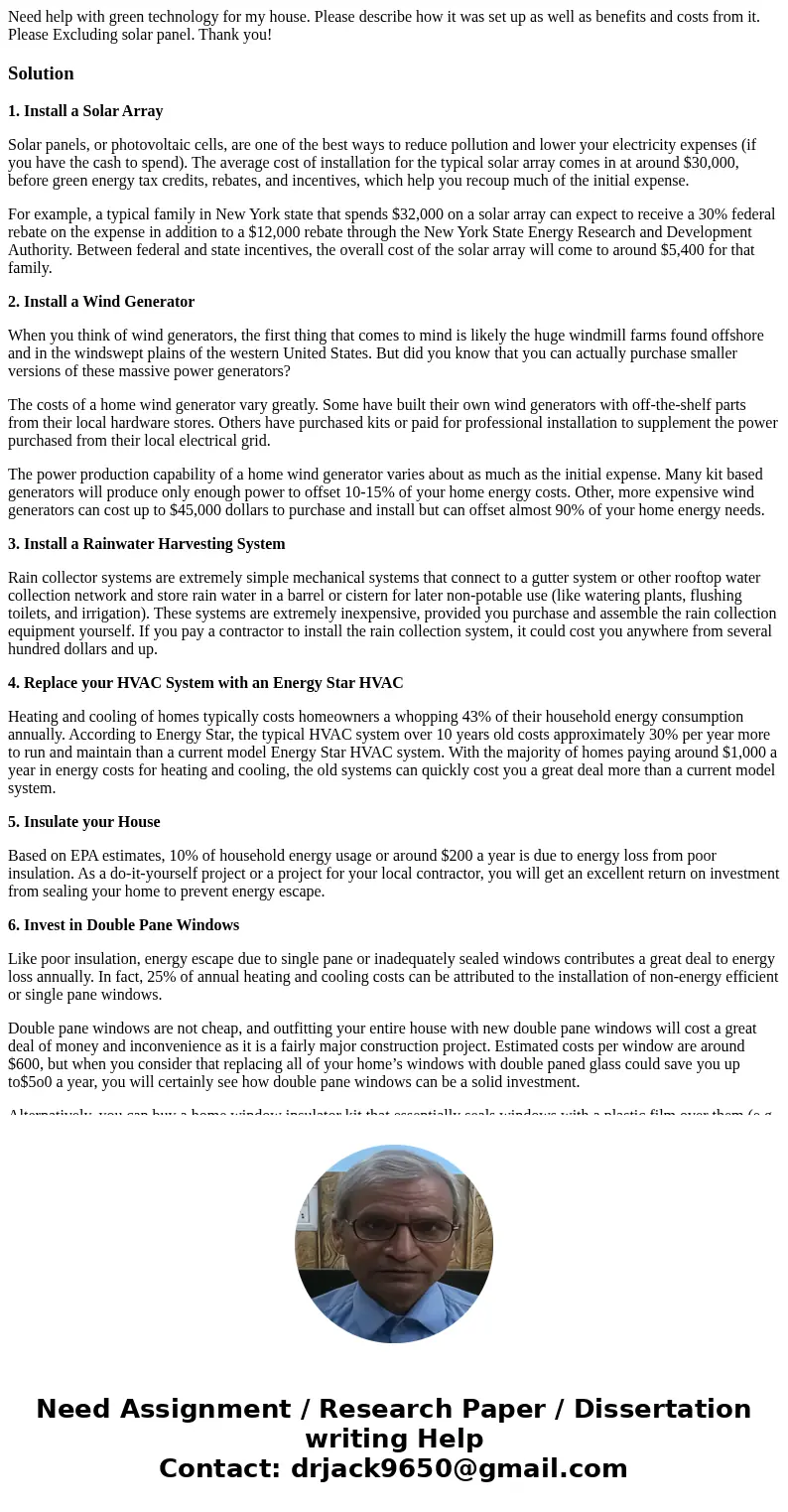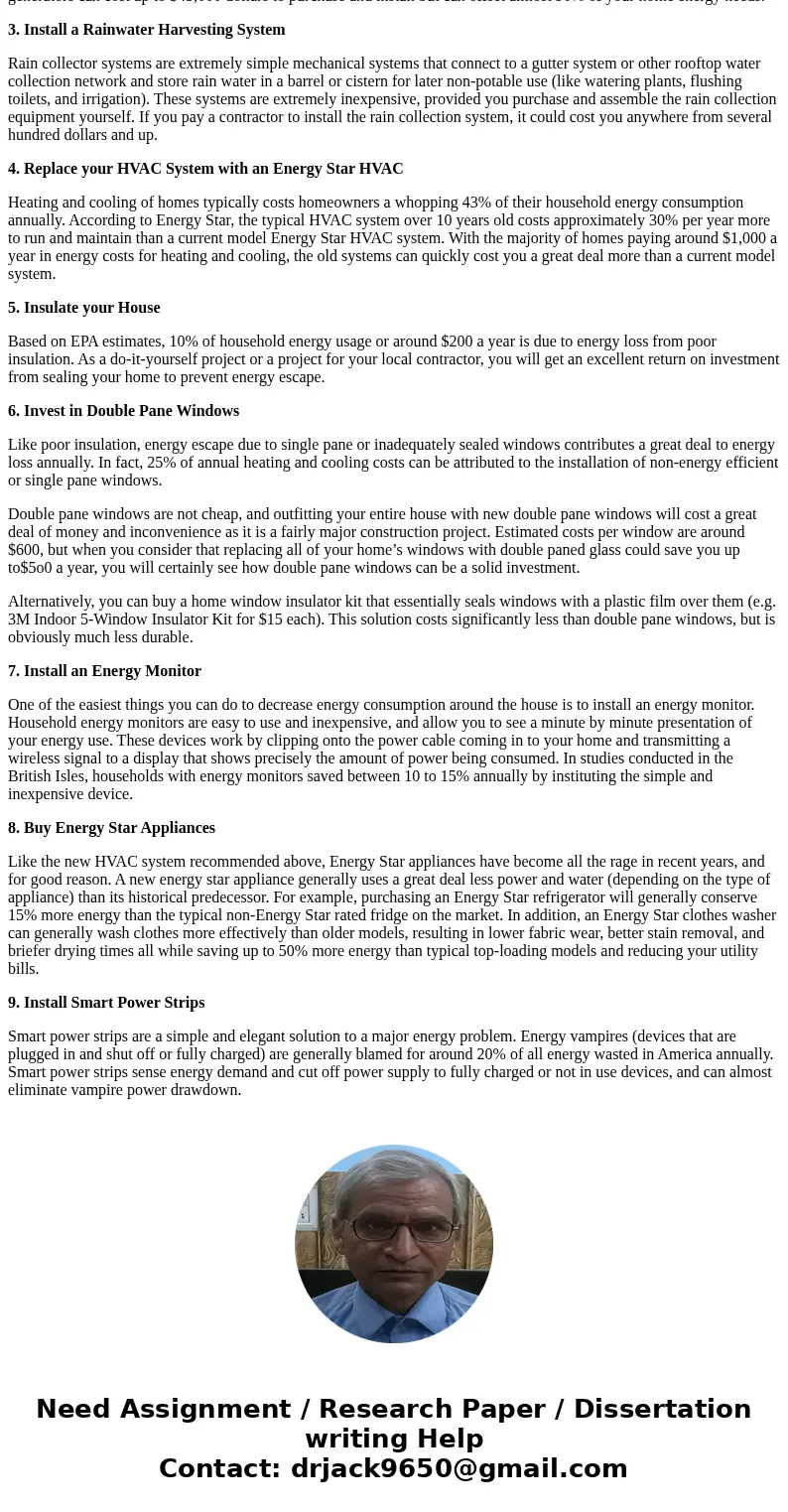Need help with green technology for my house Please describe
Need help with green technology for my house. Please describe how it was set up as well as benefits and costs from it. Please Excluding solar panel. Thank you!
Solution
1. Install a Solar Array
Solar panels, or photovoltaic cells, are one of the best ways to reduce pollution and lower your electricity expenses (if you have the cash to spend). The average cost of installation for the typical solar array comes in at around $30,000, before green energy tax credits, rebates, and incentives, which help you recoup much of the initial expense.
For example, a typical family in New York state that spends $32,000 on a solar array can expect to receive a 30% federal rebate on the expense in addition to a $12,000 rebate through the New York State Energy Research and Development Authority. Between federal and state incentives, the overall cost of the solar array will come to around $5,400 for that family.
2. Install a Wind Generator
When you think of wind generators, the first thing that comes to mind is likely the huge windmill farms found offshore and in the windswept plains of the western United States. But did you know that you can actually purchase smaller versions of these massive power generators?
The costs of a home wind generator vary greatly. Some have built their own wind generators with off-the-shelf parts from their local hardware stores. Others have purchased kits or paid for professional installation to supplement the power purchased from their local electrical grid.
The power production capability of a home wind generator varies about as much as the initial expense. Many kit based generators will produce only enough power to offset 10-15% of your home energy costs. Other, more expensive wind generators can cost up to $45,000 dollars to purchase and install but can offset almost 90% of your home energy needs.
3. Install a Rainwater Harvesting System
Rain collector systems are extremely simple mechanical systems that connect to a gutter system or other rooftop water collection network and store rain water in a barrel or cistern for later non-potable use (like watering plants, flushing toilets, and irrigation). These systems are extremely inexpensive, provided you purchase and assemble the rain collection equipment yourself. If you pay a contractor to install the rain collection system, it could cost you anywhere from several hundred dollars and up.
4. Replace your HVAC System with an Energy Star HVAC
Heating and cooling of homes typically costs homeowners a whopping 43% of their household energy consumption annually. According to Energy Star, the typical HVAC system over 10 years old costs approximately 30% per year more to run and maintain than a current model Energy Star HVAC system. With the majority of homes paying around $1,000 a year in energy costs for heating and cooling, the old systems can quickly cost you a great deal more than a current model system.
5. Insulate your House
Based on EPA estimates, 10% of household energy usage or around $200 a year is due to energy loss from poor insulation. As a do-it-yourself project or a project for your local contractor, you will get an excellent return on investment from sealing your home to prevent energy escape.
6. Invest in Double Pane Windows
Like poor insulation, energy escape due to single pane or inadequately sealed windows contributes a great deal to energy loss annually. In fact, 25% of annual heating and cooling costs can be attributed to the installation of non-energy efficient or single pane windows.
Double pane windows are not cheap, and outfitting your entire house with new double pane windows will cost a great deal of money and inconvenience as it is a fairly major construction project. Estimated costs per window are around $600, but when you consider that replacing all of your home’s windows with double paned glass could save you up to$5o0 a year, you will certainly see how double pane windows can be a solid investment.
Alternatively, you can buy a home window insulator kit that essentially seals windows with a plastic film over them (e.g. 3M Indoor 5-Window Insulator Kit for $15 each). This solution costs significantly less than double pane windows, but is obviously much less durable.
7. Install an Energy Monitor
One of the easiest things you can do to decrease energy consumption around the house is to install an energy monitor. Household energy monitors are easy to use and inexpensive, and allow you to see a minute by minute presentation of your energy use. These devices work by clipping onto the power cable coming in to your home and transmitting a wireless signal to a display that shows precisely the amount of power being consumed. In studies conducted in the British Isles, households with energy monitors saved between 10 to 15% annually by instituting the simple and inexpensive device.
8. Buy Energy Star Appliances
Like the new HVAC system recommended above, Energy Star appliances have become all the rage in recent years, and for good reason. A new energy star appliance generally uses a great deal less power and water (depending on the type of appliance) than its historical predecessor. For example, purchasing an Energy Star refrigerator will generally conserve 15% more energy than the typical non-Energy Star rated fridge on the market. In addition, an Energy Star clothes washer can generally wash clothes more effectively than older models, resulting in lower fabric wear, better stain removal, and briefer drying times all while saving up to 50% more energy than typical top-loading models and reducing your utility bills.
9. Install Smart Power Strips
Smart power strips are a simple and elegant solution to a major energy problem. Energy vampires (devices that are plugged in and shut off or fully charged) are generally blamed for around 20% of all energy wasted in America annually. Smart power strips sense energy demand and cut off power supply to fully charged or not in use devices, and can almost eliminate vampire power drawdown.


 Homework Sourse
Homework Sourse